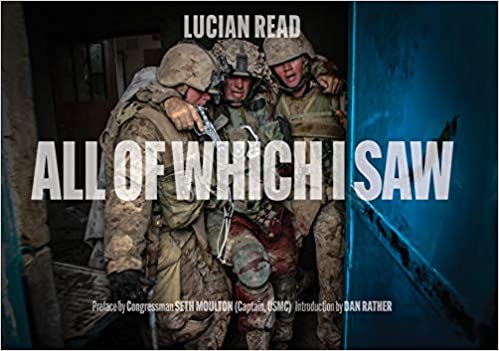
Reviewed by Major Chris Ketcherside, USMC (Ret.)
Lucian Read is a photojournalist who was embedded with the 11th Marine Expeditionary Unit during the fighting for An Najaf and then later with 3rd Bn, 1st Marines during the assault on Fallujah. All of Which I Saw is a selection of photographs and journal entries he made during that time.
Lucian Read is a photojournalist who was embedded with the 11th Marine Expeditionary Unit during the fighting for An Najaf and then later with 3rd Bn, 1st Marines during the assault on Fallujah. All of Which I Saw is a selection of photographs and journal entries he made during that time.
The pictures are both striking and stark, capturing a wide range of the experiences a U.S. Marine could have while deployed. This includes everything from combat, wounds, and surgery to playing video games, sleeping in odd places, and aspects of life aboard ship. These pictures are presented without captions, explanations, or context, but sprinkled intermittently are excerpts from Read’s journal he kept during his time embedded.
These pictures and journal entries do not tell the story of the battle, but rather attempt to convey what it looked, smelled, and felt like to be there. Perhaps this is best illustrated by the section detailing the actions in the “Kill House” in Fallujah where Read took his most famous photograph of then 1st Sgt. Bradley Kasal. In the journal entries he made right after the fight, he truly captures the confusion, fear, and heroism of the Marines in that gunfight.
From a historian’s point of view the book has some drawbacks. It may be difficult to look at the pictures without wanting to know more…who they are, what they are doing, where they are at, and so on. Fortunately, the captions for the photographs are in the back, so your historical thirst may be slaked, but it requires some flipping back and forth to appreciate the picture in its full size and know what it is of. Also, the journal entries are, like the pictures, directly from the event. That is, they also do not have context or explanation. Read uses the terms that would have been part of his lexicon at the time, like CAAT and high back, but provides no explanation of these for the reader. Inexplicably, one of these terms is “first sarnt” used to refer to various 1st Sergeants. We are left wondering if Read misunderstood, or if this was a local colloquialism used by 3rd Bn 1st Marines. This reader spent 18 years in the Marines and never heard or saw the term first sarnt used to refer to anything.
These criticisms only apply if one is looking for a strictly historical book, which All of Which I Saw is not meant to be. The book gives the reader, to some degree, a sense of what it was like to be there. Read’s work would be a good pairing with some other more traditional monograph like Dick Camp’s Battle for the City of the Dead and Operation Phantom Fury which cover An Najaf and Fallujah respectively or even David Bellavia’s House to House or Selling War by Steven Alvarez, both of which are more personal accounts but also more traditional histories.
Ultimately, Read succeeds in portraying moments rather than events. In the last journal entry he includes, he discusses his upcoming return to the U.S. and what he is both looking forward to and glad to be getting away from. But he also talks about what he will miss, saying “I fear the freedom to awake each day and have that day fulfill no purpose, to wake up to a world where history is not being played out on my doorstep, the freedom to live in a miasma of endless phone calls, bills, emails, errands and appointments.” Having served as a U.S. Marine in Iraq, this reviewer can attest that Read captured that feeling perfectly.
Major Chris Ketcherside, USMC (Ret.) served in Iraq in 2004. He is now an adjunct professor of history at the Missouri University of Science and Technology and a PhD student at the University of St. Louis.
All of Which I Saw: With the US Marine Corps in Iraq (Lucian Read, Schiffer Military, Atglen, PA, 2019)


Ignacio Plaza
Ignacio Plaza